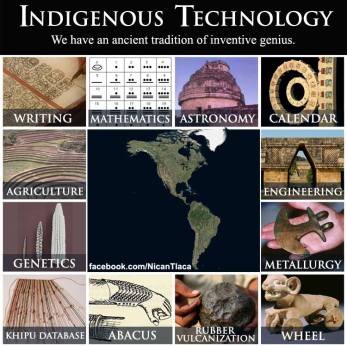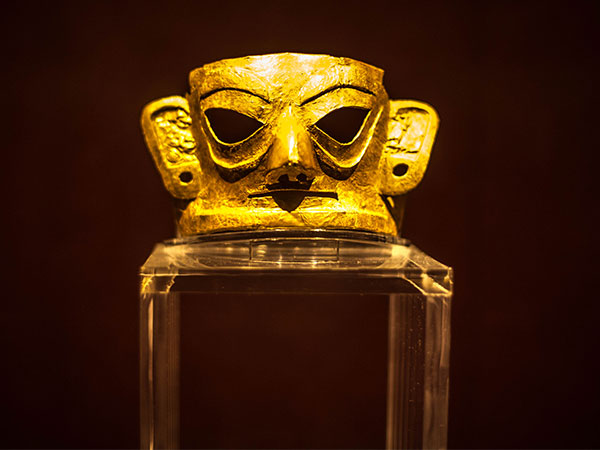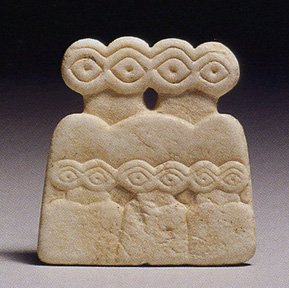
October 12th is Columbus Day, a day which is increasingly coming under criticism for celebrating a genocidal pirate, murderer, rapist, and enslaver who is credited with the “discovery” of the Western Hemisphere.
Most people today dismiss the notion that Columbus “discovered” a land that was already packed with 100 million people and 6,000 years of thriving civilizations (the earliest urban center with communal architecture is at Porvenir, Peru, dating back to 4930 B.C., according to Haas et al, 2004).
The world that Europeans “encountered” (read: “invaded”) was not that of a barren wilderness, sparsely populated by nomadic tribes; but a continent filled with wealthy, urban civilizations and complex, sedentary farming cultures. The Western Hemisphere of 1492 was a land of cities, writing, mathematics, astronomy, calendars, and engineering (listen to the Charles Mann interview for more information).
Unknown to most people is the enormity of Columbus’ genocidal actions, as well as its deadly legacy lasting into modern times. Genocide expert David Stannard has asserted that, beginning in 1492 with Columbus, Europeans collectively killed between 70 million to 100 million Indigenous People (within 80 years). In his book American Holocaust, Stannard calls this “the largest ongoing holocaust in the history of humanity.” The consequences of this Indigenous Holocaust were world-changing: 95% of Indigenous People were killed by European actions, 100% of Indigenous lands were stolen, and European-descent people became the most prosperous people on the planet.
Background on Columbus
Spain was the perfect place for pirate and slave-trader Christopher Columbus to go as he looked for financial backing for further naval exploitations. In 1492, Spain was an environment hot with the fervor of Holy Wars against Muslims and the expulsions of Jews out of Spain.
The following video by Nican Tlaca University explains more:
http://www.youtube.com/watch?v=o51LPfrjsqQ
Acts of Genocide
The genocidal actions of Columbus and other Europeans who followed in his footsteps (e.g. Cortes, DeSoto, Pizarro, et al) can be classified into two general categories:
Biological genocide: spreading smallpox as a weapon of warfare, massacres of unarmed delegates, execution of leaders, death marches, death-by-torture, death-by-exhaustion/malnutrition, etc.
Cultural genocide: the deliberate destruction of books, buildings, and other cultural assets for the purpose of undermining cultural identity, development, and self-determination.
The following video by Nican Tlaca University describes more:
http://www.youtube.com/watch?v=DD80NJj0FzU
Genocide Sanctioned By Law
It was the Catholic Church which established a “Genocide By Law” tradition through the issuing of Papal Bulls (Christian Declarations), granting European-Christians the rights to invade, enslave, and plunder the lands of non-Christians.
This tradition of Church-sanctioned crime led to the Doctrine of Discovery, which stated that Europeans have the right to invade, steal, rape, enslave, and colonize worldwide people and lands in the name of Jesus Christ and “salvation”. This doctrine was perhaps nowhere more blatant than in the Spanish-colonial tradition of reading aloud document called The Requirement, just before invading Indigenous lands. An excerpt from The Requirement is as follows:
“But if you do not do this, and maliciously make delay in it, I certify to you that, with the help of God, we shall powerfully enter into your country, and shall make war against you in all ways and manners that we can, and shall subject you to the yoke and obedience of the Church and of their highnesses; we shall take you, and your wives, and your children, and shall make slaves of them, and as such shall sell and dispose of them as their highnesses may command; and we shall take away your goods, and shall do you all the mischief and damage that we can, as to vassals who do not obey, and refuse to receive their lord, and resist and contradict him: and we protest that the deaths and losses which shall accrue from this are your fault, and not that of their highnesses, or ours, nor of these cavaliers who come with us “.source: https://en.wikipedia.org/…
Other legal methods of codifying destruction and subordination were:
The 1577 Law of Book Burning – this Spanish law demanded the burning of all Indigenous books.
Spanish Inquisition imported from Spain – most people associate the Inquisition and its horrors with Europe. But the Inquisition was also imported into Spanish Colonies.
Racial caste system – White Supremacy was codified into a “bloody purity” caste system which still survives today (albeit informally).
Encomienda system (slavery) – this slave system granted entire Indigenous communities over to Spaniards who could work them to death, rape them, and otherwise act with impunity.
Reservation/Reserves – mainly practiced in “The United States” and Canada, this practice herded Indigenous People – like animals — onto barren, unwanted lands.
The Columbus Formula
The Columbus Formula was replicated by subsequent European invaders. Briefly, the Columbus Formula included the following:
- Pretend to come in peace, bringing “freedom” or “salvation”
- Massacre unarmed people
- Take the leader hostage
- Extort the population for gold, silver
- Murder the leader
- Terrorize the population
- Fan the flames of smallpox infection
Much of this may sound familiar in our age of “The Bush Doctrine”, whereby American foreign policy is based on “pre-emptive war” (invasion) in the name of “Democracy” and ‘Freedom”. Just as the American government is a direct descendant of European Colonial governments, so too is modern American foreign policy a direct descendant of European-Colonial “Indian Policy”.
Modern Legacy of Genocide Since 1492
- Poverty for Indigenous People
- Racial Caste System still in effect (informally)
- “Illegal Immigration” (Indigenous People are classified as criminals for migrating across European-colonial borders.)
- Reservations
- Forced Sterilization of Indigenous Women
- Indian Schools (the most famous are the Indian Boarding Schools, but these have their origins in the missionary schools of early colonial Mexico. These school systematically exterminated Indigenous culture: languages, writing, mathematics, theology, and pride.)
- Latino/Hispanic (an attempt to whitewash the Indigenous-descent population, making them a sub-category of Spanish imperialism.)
- Manifest Destiny (the theft of Indigenous lands and parceling it out to white settlers)
- United Fruit Company and Monsanto – corporate colonialism of lands and resources
- Genocide of Mayans in Guatemala 1980s – hundreds of thousands were killed by paramilitary forces funded by the United States.
- Bush Doctrine – pre-emptive invasion in the name of “saving them with Democracy”.
- IMF, WTO, World Bank – this “triad” oversees (read: strong-arms) the world economy on behalf of “The West”. These institutions are run by Europeans to “develop” non-white nations, charging them huge interest on debts loaned out with numerous “structural reform” strings attached.
Conclusion
Columbus Day is more than just a holiday celebrating a man who merely “mistreated the natives”. “Mistreatment”, “depopulation”, and other euphemisms for genocide, torture, rape, and enslavement do an injustice to the horror story that is The Columbus Genocide Legacy. Columbus Day honors the architect of 521 years of continuous genocidal actions against Indigenous People.
To criticize Columbus Day merely on the notion that he did not “discover” an already-inhabited hemisphere is inadequate. The real significance of Columbus Day lies in the fact he established the Indigenous Holocaust Formula, leading to the extermination of 70 million to 100 Million Indigenous People and the theft of Indigenous lands.
This genocide paved the way for Europeans to acquire lands for “free”. The enormous wealth of the Western Hemisphere transformed Europe into a wealthy continent, and provided white settlers with “opportunities” which they would not have otherwise found back inside Europe.
Today, “Corporate Conquistadors” continue to plunder the world on behalf of “The West” (European-descent people), plundering natural resources from those who need them the most, and imposing poverty-producing conditions on struggling economies.
The cultural genocide continues today as well. A current proposal is underway to construct a “Museum of the American Latino” which plans to glorify Spaniards and their colonial past, while subsuming Indigenous-descent people under the categories of Hispanic/Latino, as a way of erasing their identity and voices.
Sources:
Genocide: A Comprehensive Introduction
American Indian Contributions to the World
1491: New Revelations on the Americas
Year 501: The Conquest Continues by Noam Chomsky
Pagans In The Promised Land: Decoding The Doctrine of Discovery
http://www.dailykos.com/story/2013/10/12/1246553/-Columbus-and-The-Legacy-of-Genocide
Visit the Nican Tlaca Facebook page for more information




























 ]
]
























































































